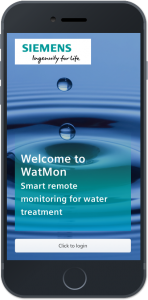Water-treatment technology provider EnWat was experiencing high expenses in maintaining its customers’ facilities. A remote monitoring digital solution has helped bringing down costs for good.
Specialized equipment requires expert maintenance – such as the chemical-free water treatment technology manufactured and serviced by German company EnWat. Yet, with no central control system and no uniform monitoring, maintaining customers facilities had proven to be expensive and time consuming.

The MindSphere-based application allows remote monitoring of decentralized water treatment and distribution systems.
In 2018, EnWat’s CEO Klaus Strätz submitted a use case in the MindSphere Open Space Challenge to find a corresponding digital solution. Within the challenge, different teams compete to create solutions for these use cases. For the EnWat entry, a jury of experts found a clear winner in the concept from the Siemens MindSphere Application Center (MAC) in Alpharetta, Georgia. Now, one year later, EnWat has established a monitoring system for all its sites. Ninety percent of the sites visits that were previously performed are no longer necessary – thanks to fast-track digitalization.
Water Treatment Monitoring (WatMon) is the name of the MindSphere-based application developed for EnWat. It collects data from distributed systems via secure channels and analyzes it using advanced algorithms. Custom alarms created by the user issue notifications on critical events. The information and operational parameters are presented in a globally accessible dashboard for high process transparency. The application offers real-time remote monitoring for decentralized assets in a web browser, which can be accessed via a desktop, smartphone or tablet. This functionality enables easy operation, planning and tracking of maintenance activities – anywhere, anytime.
The solution is suitable for any domain in which a central analysis of decentralized assets makes sense
Lean startup methodology was used to establish this solution. “The lean startup approach enables solutions to be delivered fast to our customers,” comments Firas Khalil, Head of Digital Enterprise Lab Americas at Siemens. The first step is an ideation workshop in which the MAC staff members have the chance to dig deeper into the use case, refine it and ask questions. They learn more about pain points and customer goals. In the case of EnWat, it was revealed that staff at the company’s central operations needed to dial in to each site individually to read certain process parameters and check that the site was operating properly. This was necessary because there was no Supervisory Control and Data Acquisition (SCADA) system in place.
“Due to the lack of information, service technicians had to make site visits. It wasn’t unusual for them to travel up to 300 kilometers to an installation to determine that everything was actually in order,” says Strätz. With the information from the ideation workshop, a mission statement focusing on delivering value to the customer is formulated.
The customer as a partner
With the mission statement in hand, the next phase following a minimum viable product (MVP) approach can begin. In this user-centric design approach, larger tasks are broken down into individual steps, which are worked on in sprints using real data from the customer’s installations. Every two weeks, the team presents the results and gets customer feedback, which is taken into consideration for the next sprint.
“The advantage of this co-creation approach is that the customer knows at all times where we are heading. There is no chance of coming up with something that the customer doesn’t want. This allows us to build scalable applications with a fast time to market,” says Michael Sonst, Head of Product & Solution Development at the MAC. Furthermore, experience has shown that strong customer involvement leads to overall higher satisfaction with the developed products and solutions.
After the pilot phase the app is ready to be officially rolled out – in the EnWat project, that was in the space of just one year. “In the past, software projects like this took much longer to implement. One year is very short,” underlines Loveleen Sharma, Product Owner of the WatMon app at Siemens.
However, the experience of the Alpharetta team in process industries also came to play, particularly special knowledge in digitalizing operations. An example is Smart Mining, which provides real-time analytics and optimization for mining operations with the ultimate goal of reducing unplanned downtime. In the case of anomalies, it provides access to know-how in the cloud to help determine root causes and initiate appropriate countermeasures.
Water Treatment Monitoring was designed for EnWat to more efficiently maintain innovative drinking water treatment technology at diverse sites. However, the solution can also be used in other industries, in which a central analysis of decentralized assets makes sense.
Copyright: siemens.com/stories
